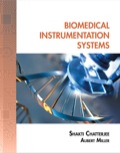
EBK BIOMEDICAL INSTRUMENTATION SYSTEMS
1st Edition
ISBN: 8220100456961
Author: Chatterjee
Publisher: YUZU
expand_more
expand_more
format_list_bulleted
Question
error_outline
This textbook solution is under construction.
Knowledge Booster
Learn more about
Need a deep-dive on the concept behind this application? Look no further. Learn more about this topic, bioengineering and related others by exploring similar questions and additional content below.Similar questions
- A urinalysis reveals that the patients urine contains glucose, hemoglobin, and white blood cells (pus). Are any of these substances abnormal in urine? Explain.arrow_forwardThe rate at which the Na+K+ pump operates is not constant but is controlled by a combined effect of changes in ICF Na+ concentration and ECF K+ concentration. Do you think the changes in both ICF Na+ and ECF K+ concentration following a series of action potentials in a neuron would accelerate, slow down, or have no effect on the Na+K+ pumps in this cell?arrow_forwardDescribe the contribution of each of the following to establishing and maintaining membrane potential: (a) the Na+K+ pump, (b) passive movement of K+ across the membrane, (c) passive movement of Na+ across the membrane, and (d) the large intracellular anions.arrow_forward
- _____________________ Plasmapheresis is the removal of whole blood from the body, separation of its cellular elements, and reinfusion of these cellular elements suspended in saline or a plasma substitute.arrow_forwardView these animations (http://openstaxcollege.org/l/coagulation) to explore the intrinsic, extrinsic, and common pathways that are involved the process of coagulation. The coagulation cascade restores hemostasis by activating coagulation factors in the presence of an injury. How does the endothelium of the blood vessel walls prevent the blood from coagulating as it flows through the blood vessels?arrow_forwardWhich of the following does not contribute to the process of filtration? (a) active transport by epithelial cells lining renal tubules (b) large surface area for filtration (c) low permeability of glomerular capillaries (d) high hydrostatic blood pressure in glomerular capillaries (e) podocytesarrow_forward
arrow_back_ios
arrow_forward_ios
Recommended textbooks for you
 Human Physiology: From Cells to Systems (MindTap ...BiologyISBN:9781285866932Author:Lauralee SherwoodPublisher:Cengage Learning
Human Physiology: From Cells to Systems (MindTap ...BiologyISBN:9781285866932Author:Lauralee SherwoodPublisher:Cengage Learning Human Biology (MindTap Course List)BiologyISBN:9781305112100Author:Cecie Starr, Beverly McMillanPublisher:Cengage Learning
Human Biology (MindTap Course List)BiologyISBN:9781305112100Author:Cecie Starr, Beverly McMillanPublisher:Cengage Learning


Human Physiology: From Cells to Systems (MindTap ...
Biology
ISBN:9781285866932
Author:Lauralee Sherwood
Publisher:Cengage Learning



Human Biology (MindTap Course List)
Biology
ISBN:9781305112100
Author:Cecie Starr, Beverly McMillan
Publisher:Cengage Learning

Thermogravimetric Analysis [ TGA ] # Thermal Analysis # Analytical Chemistry Part-11# CSIR NET/GATE; Author: Priyanka Jain;https://www.youtube.com/watch?v=p1K-Jpzylso;License: Standard YouTube License, CC-BY